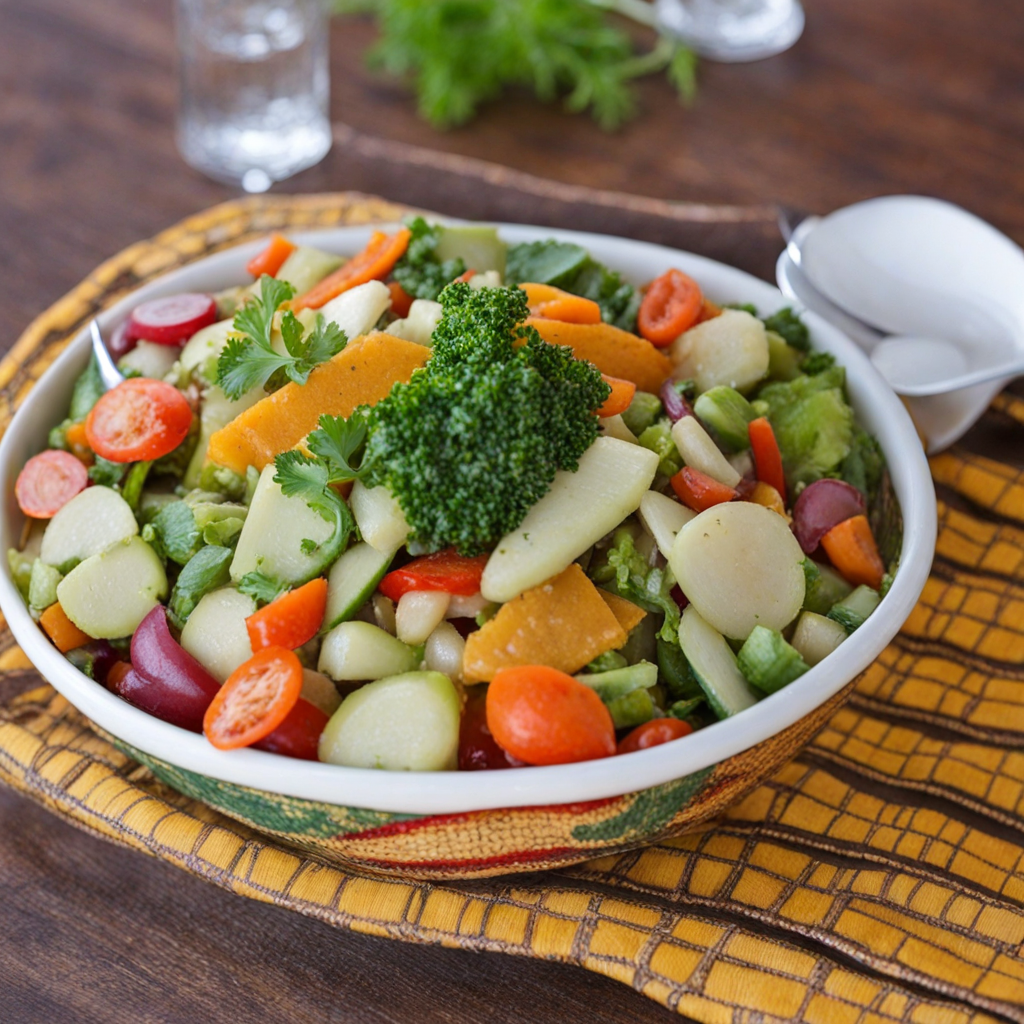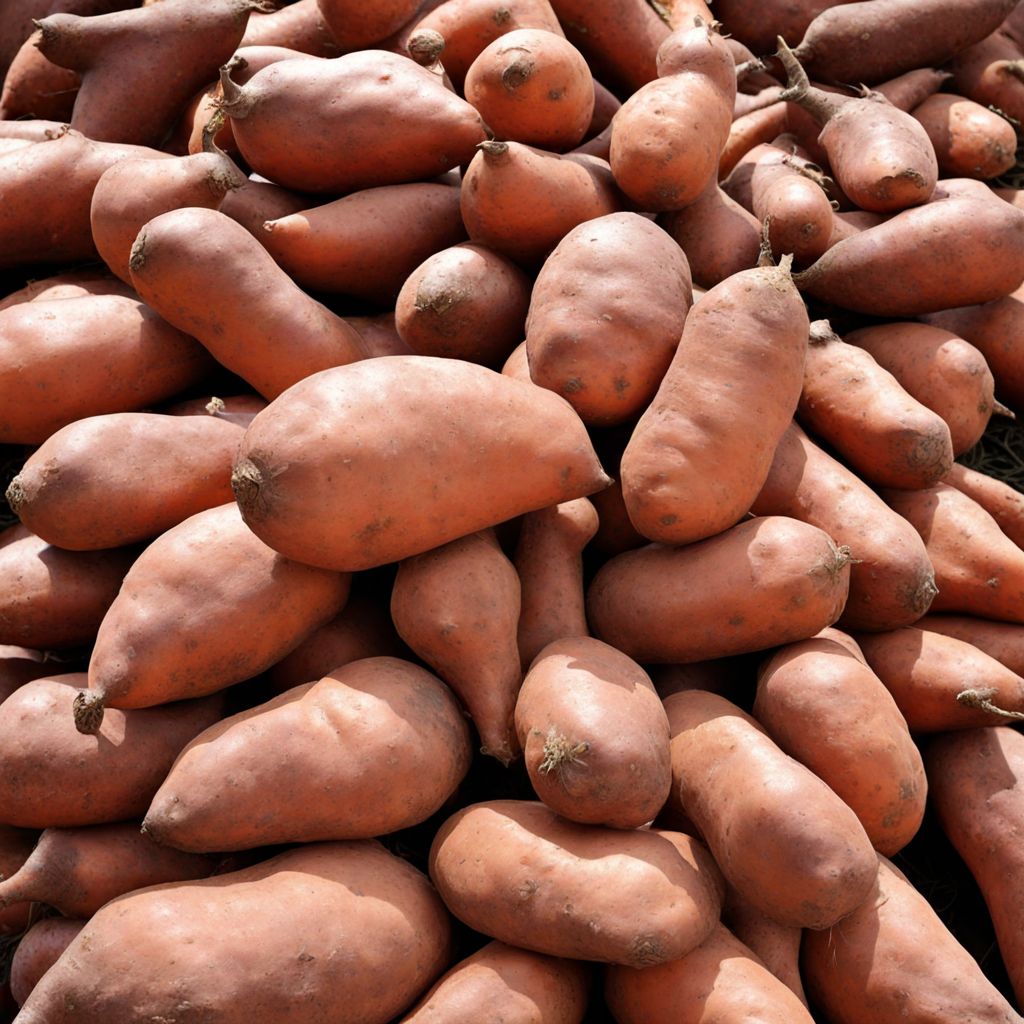Slaai
Slaai is a vibrant and refreshing dish hailing from Eswatini, known for its delightful combination of flavors and textures. Traditionally, this salad is crafted from a variety of fresh ingredients, including crisp greens, ripe tomatoes, and crunchy cucumbers, often enhanced with the addition of local herbs and spices. The use of seasonal vegetables ensures that each bite bursts with freshness, making it a staple in both everyday meals and festive occasions. The colors of Slaai are visually appealing, showcasing the rich agricultural bounty of Eswatini, and inviting those who encounter it to dive into its wholesome goodness. One of the standout features of Slaai is its dressing, which typically combines tangy citrus juices, such as lemon or lime, with a drizzle of local oils and a hint of chili for a gentle kick. This dressing perfectly complements the salad’s fresh ingredients, elevating the overall flavor profile while allowing the natural tastes of the vegetables to shine through. Some variations of Slaai incorporate avocado or even protein sources like beans or grilled meats, adding creaminess and heartiness to the dish, making it versatile for both vegetarian and omnivore diets. Beyond its delicious taste, Slaai is a celebration of community and culture in Eswatini. Often enjoyed during gatherings and special meals, it serves as a reminder of the importance of sharing and enjoying food together. This dish reflects the essence of Eswatini’s culinary heritage, where simplicity meets flavor, encouraging food lovers to embrace new tastes and experiences. Slaai is not just a meal; it’s an invitation to explore the rich agricultural traditions and vibrant flavors of Eswatini.
How It Became This Dish
The History of Slaai: A Culinary Treasure of Eswatini #### Introduction Slaai, a delightful salad originating from Eswatini (formerly Swaziland), serves as a testament to the vibrant culture and agricultural richness of this southern African nation. Though simple in its ingredients, Slaai carries deep cultural significance, reflecting the harmony between the land and its people. This exploration of Slaai's history traces its origins, cultural importance, and evolution through time, revealing how this dish has become a symbol of identity and community in Eswatini. #### Origins of Slaai The roots of Slaai can be traced back to Eswatini's diverse agricultural practices. Nestled between South Africa and Mozambique, Eswatini has a rich tradition of farming, influenced by its varied climate and fertile soils. The country is known for cultivating a plethora of fruits and vegetables, many of which find their way into Slaai. Ingredients commonly used in Slaai include tomatoes, onions, cucumbers, and greens like lettuce or spinach, which are often harvested fresh from local gardens. Traditionally, Slaai was not just a standalone dish but a component of the broader meal that included staple foods such as maize meal (putu) and meat stews. It was a way to incorporate fresh produce into the diet, providing essential nutrients while celebrating the bounty of the land. Over time, Slaai has evolved, integrating various ingredients and flavors, reflecting the culinary influences of neighboring regions while maintaining its roots in local agricultural practices. #### Cultural Significance In Eswatini, food is more than sustenance; it is a medium of social interaction and cultural expression. Slaai plays a pivotal role in communal gatherings, family celebrations, and traditional events. It is often prepared for weddings, funerals, and other significant occasions, symbolizing unity and the sharing of resources. The act of preparing and sharing Slaai fosters community bonding, where families come together to create a dish that is both personal and communal. The ingredients of Slaai are often chosen based on availability and seasonality, which speaks to the Swazi people's deep connection to their environment. For example, during certain seasons, avocados or mangoes may be added to the salad, reflecting the changing cycles of nature. This practice promotes sustainability and a sense of appreciation for the land, as families utilize what is at hand while celebrating the flavors of the season. Moreover, Slaai embodies the Swazi principle of "ubuntu," which emphasizes togetherness and collective responsibility. Sharing food is an essential aspect of Swazi culture, reinforcing relationships and creating a sense of belonging. Slaai, with its vibrant colors and diverse ingredients, becomes a visual representation of this philosophy, inviting everyone to partake in the experience. #### Development Over Time As Eswatini has navigated the complexities of modernization and globalization, Slaai has also transformed. Initially a simple blend of local vegetables and herbs, contemporary interpretations of Slaai have begun to incorporate international ingredients and flavors. The influx of Western culinary practices, particularly in urban areas, has introduced items such as feta cheese, olives, and even exotic dressings, which have found their way into local recipes. Despite these changes, traditional preparations remain integral to Slaai's identity. Many Swazi families continue to prepare Slaai using age-old recipes passed down through generations. These traditional versions often emphasize freshness, simplicity, and the use of locally sourced ingredients, ensuring that Slaai remains connected to its cultural heritage. The introduction of Slaai into the global culinary scene has also sparked interest in Eswatini's cuisine. As international travelers and food enthusiasts explore the flavors of southern Africa, Slaai has gained recognition as a symbol of Swazi hospitality. Restaurants and food festivals now highlight Slaai, showcasing its versatility and appeal to a broader audience. This increased visibility has encouraged a resurgence of interest in traditional cooking practices, prompting younger generations to appreciate and preserve their culinary heritage. #### Modern Variations and Global Influence In contemporary Eswatini, Slaai has evolved into diverse variations that reflect individual tastes and preferences. Some families may add proteins like grilled chicken or beans to make the salad more substantial, while others might experiment with unique dressings that blend traditional ingredients with global flavors. The rise of health consciousness has further influenced Slaai's development, with many opting for lighter, more nutritious versions that emphasize fresh, raw vegetables. Additionally, the concept of fusion cuisine has made its mark on Slaai. Swazi chefs and home cooks are now reimagining Slaai by incorporating elements from other culinary traditions, such as Indian spices or Mediterranean herbs. This creative exploration of flavors has led to exciting new interpretations of Slaai that still honor the original spirit of the dish. As Eswatini continues to engage with the global community, Slaai stands as both a culinary delight and a cultural artifact. It embodies the resilience of Swazi culture in the face of change while celebrating the rich agricultural heritage of the nation. The dish serves as a bridge between generations, uniting the past and present, tradition and innovation. #### Conclusion Slaai is more than just a salad; it is a reflection of Eswatini's history, culture, and values. From its humble origins rooted in local agriculture to its contemporary interpretations that embrace global influences, Slaai has evolved while remaining deeply connected to the land and the people who cultivate it. As a staple in communal gatherings and a symbol of Swazi hospitality, Slaai continues to be a cherished dish, inviting everyone to partake in its vibrant flavors and rich cultural significance. In a world where culinary boundaries are constantly shifting, Slaai stands as a reminder of the importance of preserving cultural identity through food. It celebrates the heritage of Eswatini while inviting new interpretations and innovations, ensuring that this beloved dish will endure for generations to come.
You may like
Discover local flavors from Eswatini







